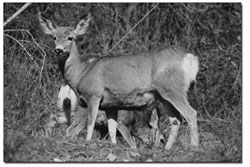|
| ||||
| Collision course SideStory: Opening safe passages: CDOT makes wildlife a priority
by Will Sands Cars and wildlife are colliding head-on on all over Southwest Colorado. Wrecks involving vehicles and wildlife are now the leading cause of accidents in the region and a unique public-private partnership is hoping to reverse the trend. Conflicts between cars and creatures are nothing new to the region. However, increasing population has intensified traffic on area roads and led to a huge jump in the number of “wildlife vehicle collisions.” Accidents involving cars and animals have risen nearly 300 percent in Colorado since 1993, according to the Colorado Department of Transportation. “In this part of the state, reducing wildlife vehicle collisions has always been a priority,” said Nancy Shanks, CDOT spokeswoman. “We’ve always looked at wildlife issues when we’ve done environmental assessments. But traffic is increasing, and our numbers are showing that the incidents are dramatically on the rise.” To begin to remedy the problem, CDOT and the Federal Highways Administration have partnered with the Southern Rockies Ecosystem Project, a science-based nonprofit group working to protect, restore and connect ecosystems in the Southern Rocky Mountains. Together, the three groups have identified 12 priority corridors in Colorado where animal and human migration overlap and conflict. Five of those are located in Southwest Colorado, and they account for the highest intensity of wildlife-related accidents in the state. “Animal-vehicle collisions are the No. 1 cause of accidents in this region,” said Monique DiGiorgio, SREP communications and development director. “We have five high priority wildlife linkages in the region, and there are only 12 in the entire state.” The five corridors include: U.S. Highway 550 north from Durango to Purgatory; U.S. Highway 160 west between Durango and Mancos; U.S. Highway 160 east between Durango and Pagosa Springs; U.S. Highway 160 at Wolf Creek Pass; and U.S. Highway 550 near Ridgway, where Colorado State Patrol trooper Mark Dold was killed Sunday after hitting a deer on his motorcycle. Collisions between cars and deer, elk, black bears, mountain lions and endangered Canada lynx are common along each of these stretches, according to DiGiorgio. On certain linkages, these collisions amount for as many as 65 percent of all accidents. “Those kinds of numbers blow the rest of the state out of the water,” DiGiorgio said. To make matters worse, that 65 percent only represents reported accidents, and Shanks said that CDOT recognizes that the problem is much more significant than the numbers are telling.
“We track the number and type of accidents so we can get an idea of what’s really going on out there,” she said. “But we also know that these numbers are only the reported accidents and account for only about half of what’s actually happening out there.” The problem has serious biological repercussions as well, according to DiGiorgio. As few as 4,000 cars per day along a stretch of highway effectively create a barrier to wildlife and fragment habitat. “Ultimately, for populations of animals to be viable they need to get across the highway,” she said. “There needs to be what we call a ‘permeable landscape.’ And once you get up to 4,000 car trips a day – which is nothing – you’ve basically created a wall for wildlife.” The best solutions are neither simple nor inexpensive. Some mitigation strategies include construction of wildlife underpasses and overpasses, wildlife fencing, roadway lighting, and signage and habitat alteration. “Crossing structures are the best answer we’ve been able to come up with,” said DiGiorgio. “However, you can’t talk about wildlife crossings without including conserved habitat on either side of the road. At that point, it becomes a long-term vision. This kind of stuff doesn’t happen overnight.” Education is a less expensive and more immediate tool that both SREP and CDOT are employing. “One of the things we’re doing involves changing motorists’ behavior rather than wildlife’s behavior,” Shanks said. “It’s not always as simple as putting up a fence. Education has to be a big part of this.” Education on the impacts of driving and the needs of the ecosystem are also vital, according to DiGiorgio. “We’re trying to broaden the discussion,” she said. “Yes, we’re talking about motorists’ safety, but we’re also taking the discussion beyond that and talking about why these animals are out there and what their needs are.” DiGiorgio added that a key part of coming efforts will be engaging members of public and creating solutions. Colorado, and Southwest Colorado in particular, are joining with Washington State and parts of Canada on the cutting edge of solving the vehicle-wildlife dilemma. “Sure, you want to be able to get on the road and drive, but do you also want to be able to live in a place that honors and preserves its wildlife?” DiGiorgio asked. “I think most people in Colorado would answer ‘yes’ to that question, and now we’re at a point where we have an opportunity to really stand out in front here and set the example.” Durango residents also have a chance to put education into play in coming months. With the onset of fall and winter just around the corner, deer, elk and predators are officially out and about and the odds are against drivers and animals. “This is certainly the time when we see wildlife on the move,” Shanks concluded. “As we all know, you can’t travel on 550 north of town without seeing a deer or elk around every corner. Now’s the time to be careful out there.” •
|



